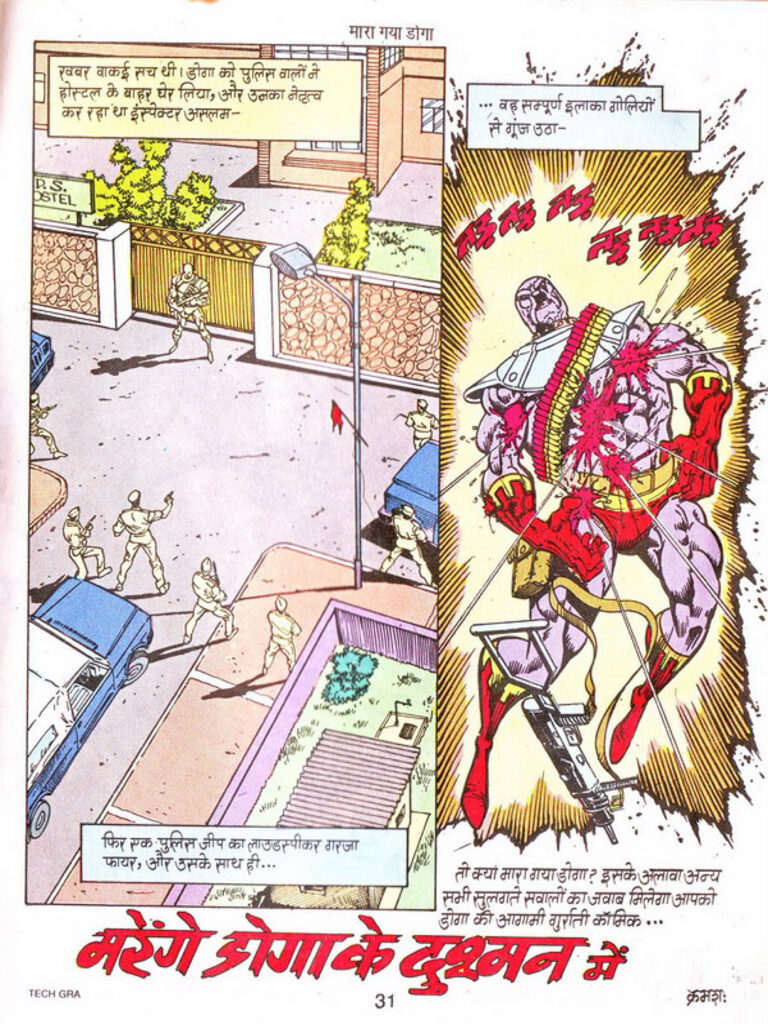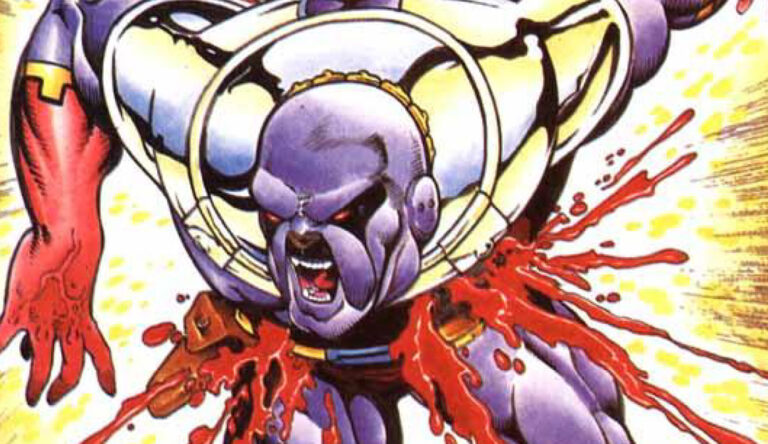Published in 1997 by Raj Comics, “Mara Gaya Doga” creates a shiver in the minds of readers just by its title. Can Doga, Mumbai’s most dreaded and ruthless anti-hero, whom criminals consider another name for death, really die? This question is the basis of this comic and keeps the readers engaged till the end. This comic is a great mix of action, drama, social sarcasm, and emotions. This story is not just about the physical end of Doga, but also the end of his image in the eyes of society.
Detailed analysis of the plot:
The story begins at Shastri Park, an ordinary-looking place in Mumbai, where a new plant of crime is growing. Four young criminals, named Shola, Daisy, Gaffura, and Sukka, are creating their own ‘images’ by selling leaked exam papers to students. They have made this mite of the education system their source of income. It is here that Mumbai’s biggest criminal-destroyer, Doga, arrives. Doga’s entry is explosive as always. He teaches these four a lesson, but here writer Tarun Kumar Wahi adds a new layer to the character of Doga. Doga is not just an action machine. He sees disorientation in the eyes of these young people and wants to give them a chance to improve. He asks them about their ringleader, “Black Face”.

That’s where the story takes an interesting turn. These four criminals, fearing and feeling humiliated by Doga’s strength, fabricate a false story. They promise Doga that they will reform and introduce him to their fictional kingpin ‘Black Face’, so that Doga can eliminate him and they are free forever. Doga, who has gone through a difficult past himself, perhaps believes their words or wants to test them, and is ready to fall into their trap.
Shola and her friends set a dangerous trap to get revenge on Doga. They groom an old friend of theirs, Pappan, the leader of a ‘street gang’, to become the ‘Black Face’. The plan was that when Doga came to meet Pappan at a restaurant called ‘Revolver’ in Diamond Tower, Pappan and his gang would eliminate him.
The middle section of the comic is full of action and tension. Doga arrives at the restaurant and realizes that he has been tricked. The fight sequence that begins after this is one of the best action sequences in Indian comics. Manu’s artwork comes alive here. Tables, chairs, bottles — everything becomes a weapon. Doga alone overpowers dozens of goons. The fight leaves the restaurant and reaches the exterior of the building and then an under-construction structure.
But the real game was not being played on the battlefield, but in the minds of the crowd standing below. Shola and her companions start spreading a new story while watching this fight from a distance. They provoke the students and common people who were present there. They introduce Doga as a villain who is killing innocent people and causing havoc in the city. They turn public sympathy in their favor. This is the most important and thought-provoking part of the story, which shows how truth can be twisted and even a protector can be made an eater (should be “enemy” or “killer” — “eater” seems mistranslated).
The climax of the story takes place atop a giant billboard, where the final battle between Doga and Pappan takes place. Doga defeats Pappan with his characteristic ruthlessness. But the crowd standing below, which was completely influenced by Shola’s lies, sees something else. They think Doga is taking the life of another innocent.

The angry and misguided mob, which feels that the law cannot stop this devil, decides to do justice on its own. They cut and break the supports of the huge hoarding on which Doga was standing. With a terrible bang, that heavy iron frame falls down, taking Doga with it.
The police arrive, the debris is removed, and Doga’s bloody, unconscious body emerges from beneath it. The news spreads like wildfire in the city — “Doga Killed.” The criminals celebrate, the police breathe a sigh of relief, and the general public thinks a danger has passed.
But did Doga really die? The final pages of the comic keep this secret, and readers know that Doga is not one to die so easily. This ending sets a great stage for the next story, “Karenge Doga’s Enemy.”
Characterization
Doga: The character of Doga is at its peak in this comic. On one hand, he is a harsh vigilante who applies the balm of cruelty, while on the other hand, he is also a sensitive person who gives opportunities to misguided youth. His being physically injured and misunderstood by the public makes him a tragic hero. He fights the system, but the people of the same system consider him their enemy.
Shola and her gang: These characters are a reflection of today’s society. They are not traditional criminals, but educated youth who want to earn money and fame through shortcuts. Their greatest strength is not their physical ability, but their ability to play with people’s minds. They show how powerful weapons lies and disinformation can be.

The public (crowd): The public is not a silent character in this story, but an active participant. It is a powerful commentary on the comic’s “crowd-mechanism” (mob mentality). It shows how, in the absence of information and under the influence of rumors, a crowd of ordinary human beings can turn into a murderous mob.
Art and Writing
Tarun Kumar Wahi’s writing is tight and impressive. The dialogues are sharp and realistic, especially Doga’s one-liners. The pace of the story is fast and does not allow any feeling of boredom anywhere. He has cleverly woven a social issue along with action.
Manu’s artwork is the soul of this story. His artwork in action scenes is worth seeing. Every panel has energy and speed. He has beautifully captured the anger, pain, and cruelty of Doga’s fight on canvas. The portrayal of Mumbai’s urban environment also makes the story more believable.
Conclusion
“Mara Gaya Doga” is not just an entertaining action comic. It is a story ahead of its time that grapples with complex questions of media trials, public perception, and vigilantism (taking the law into one’s own hands). It shows how blurred the line between hero and villain can be, and that truth often depends on who is telling the story.
Its title was more than a marketing strategy; it was the essence of the story. It broke the invincible image of Doga and brought him to a human level. This comic is as relevant today as it was in the 90s. It is an essential read for every comic lover, especially fans of Indian superheroes. It’s a story that makes you think about who the real culprit is — the one who breaks the law, or the society that gives its verdict without thinking?

1 Comment
Pingback: Marenge Doga Ke Dushman Raj Comics Review – Doga’s Darkest Battle for Justice | comicsbio.com